Early removal of the infrapatellar fat pad/synovium complex beneficially alters the pathogenesis of moderate stage idiopathic knee osteoarthritis in male Dunkin Hartley guinea pigs
- PMID: 36578046
- PMCID: PMC9795160
- DOI: 10.1186/s13075-022-02971-y
Early removal of the infrapatellar fat pad/synovium complex beneficially alters the pathogenesis of moderate stage idiopathic knee osteoarthritis in male Dunkin Hartley guinea pigs
Abstract
Background: The infrapatellar fat pad (IFP) is the largest adipose deposit in the knee; however, its contributions to the homeostasis of this organ remain undefined. To determine the influence of the IFP and its associated synovium (IFP/synovium complex or IFP/SC) on joint health, this study evaluated the progression of osteoarthritis (OA) following excision of this unit in a rodent model of naturally-occurring disease.
Methods: Male Dunkin-Hartley guinea pigs (n=18) received surgical removal of the IFP in one knee at 3 months of age; contralateral knees received sham surgery as matched internal controls. Mobility and gait assessments were performed prior to IFP/SC removal and monthly thereafter. Animals were harvested at 7 months of age. Ten set of these knees were processed for microcomputed tomography (microCT), histopathology, transcript expression analyses, and immunohistochemistry (IHC); 8 sets of knees were dedicated to microCT and biomechanical testing (material properties of knee joints tissues and anterior drawer laxity).
Results: Fibrous connective tissue (FCT) developed in place of the native adipose depot. Gait demonstrated no significant differences between IFP/SC removal and contralateral hindlimbs. MicroCT OA scores were improved in knees containing the FCT. Quantitatively, IFP/SC-containing knees had more osteophyte development and increased trabecular volume bone mineral density (vBMD) in femora and tibiae. Histopathology confirmed maintenance of articular cartilage structure, proteoglycan content, and chondrocyte cellularity in FCT-containing knees. Transcript analyses revealed decreased expression of adipose-related molecules and select inflammatory mediators in FCTs compared to IFP/SCs. This was verified via IHC for two key inflammatory agents. The medial articular cartilage in knees with native IFP/SCs showed an increase in equilibrium modulus, which correlated with increased amounts of magnesium and phosphorus.
Discussion/conclusion: Formation of the FCT resulted in reduced OA-associated changes in both bone and cartilage. This benefit may be associated with: a decrease in inflammatory mediators at transcript and protein levels; and/or improved biomechanical properties. Thus, the IFP/SC may play a role in the pathogenesis of knee OA in this strain, with removal prior to disease onset appearing to have short-term benefits.
Keywords: Biomechanics; Gait; Hartley guinea pig; Inflammation; Infrapatellar fat pad/synovium complex; Osteoarthritis; Trace elements.
© 2022. The Author(s).
Conflict of interest statement
No authors have any conflicts of interest to disclose for this work.
Figures
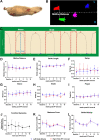
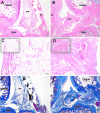
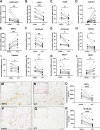
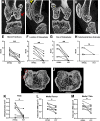
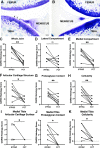


Similar articles
-
Removal of the infrapatellar fat pad and associated synovium benefits female guinea pigs in the Dunkin Hartley model of idiopathic osteoarthritis.Ann Transl Med. 2024 Jun 10;12(3):43. doi: 10.21037/atm-23-1886. Epub 2024 Jun 5. Ann Transl Med. 2024. PMID: 38911554 Free PMC article.
-
Systemic iron overload exacerbates osteoarthritis in the strain 13 guinea pig.Osteoarthritis Cartilage. 2020 Sep;28(9):1265-1275. doi: 10.1016/j.joca.2020.06.005. Epub 2020 Jul 3. Osteoarthritis Cartilage. 2020. PMID: 32629162 Free PMC article.
-
Synovium and infrapatellar fat pad share common mesenchymal progenitors and undergo coordinated changes in osteoarthritis.J Bone Miner Res. 2024 Mar 22;39(2):161-176. doi: 10.1093/jbmr/zjad009. J Bone Miner Res. 2024. PMID: 38477740 Free PMC article.
-
Pathophysiology of obesity on knee joint homeostasis: contributions of the infrapatellar fat pad.Horm Mol Biol Clin Investig. 2016 May 1;26(2):97-108. doi: 10.1515/hmbci-2015-0067. Horm Mol Biol Clin Investig. 2016. PMID: 26812879 Review.
-
Contribution of Infrapatellar Fat Pad and Synovial Membrane to Knee Osteoarthritis Pain.Biomed Res Int. 2019 Mar 31;2019:6390182. doi: 10.1155/2019/6390182. eCollection 2019. Biomed Res Int. 2019. PMID: 31049352 Free PMC article. Review.
Cited by
-
Chondrocyte fatty acid oxidation drives osteoarthritis via SOX9 degradation and epigenetic regulation.Nat Commun. 2025 May 27;16(1):4892. doi: 10.1038/s41467-025-60037-4. Nat Commun. 2025. PMID: 40425566 Free PMC article.
-
The Corpus Adiposum Infrapatellare (Hoffa's Fat Pad)-The Role of the Infrapatellar Fat Pad in Osteoarthritis Pathogenesis.Biomedicines. 2022 May 5;10(5):1071. doi: 10.3390/biomedicines10051071. Biomedicines. 2022. PMID: 35625808 Free PMC article. Review.
-
Knee adipose tissue: from its implication in osteoarthritis to its supposed role in tissue engineering.NPJ Aging. 2025 Feb 3;11(1):5. doi: 10.1038/s41514-025-00195-3. NPJ Aging. 2025. PMID: 39900591 Free PMC article.
-
Removal of the infrapatellar fat pad and associated synovium benefits female guinea pigs in the Dunkin Hartley model of idiopathic osteoarthritis.Ann Transl Med. 2024 Jun 10;12(3):43. doi: 10.21037/atm-23-1886. Epub 2024 Jun 5. Ann Transl Med. 2024. PMID: 38911554 Free PMC article.
-
Advancing Osteoarthritis Research: Insights from Rodent Models and Emerging Trends.J Orthop Sports Med. 2025;7(1):110-128. doi: 10.26502/josm.511500187. Epub 2025 Mar 14. J Orthop Sports Med. 2025. PMID: 40264810 Free PMC article.
References
Publication types
MeSH terms
Substances
Grants and funding
LinkOut - more resources
Full Text Sources

